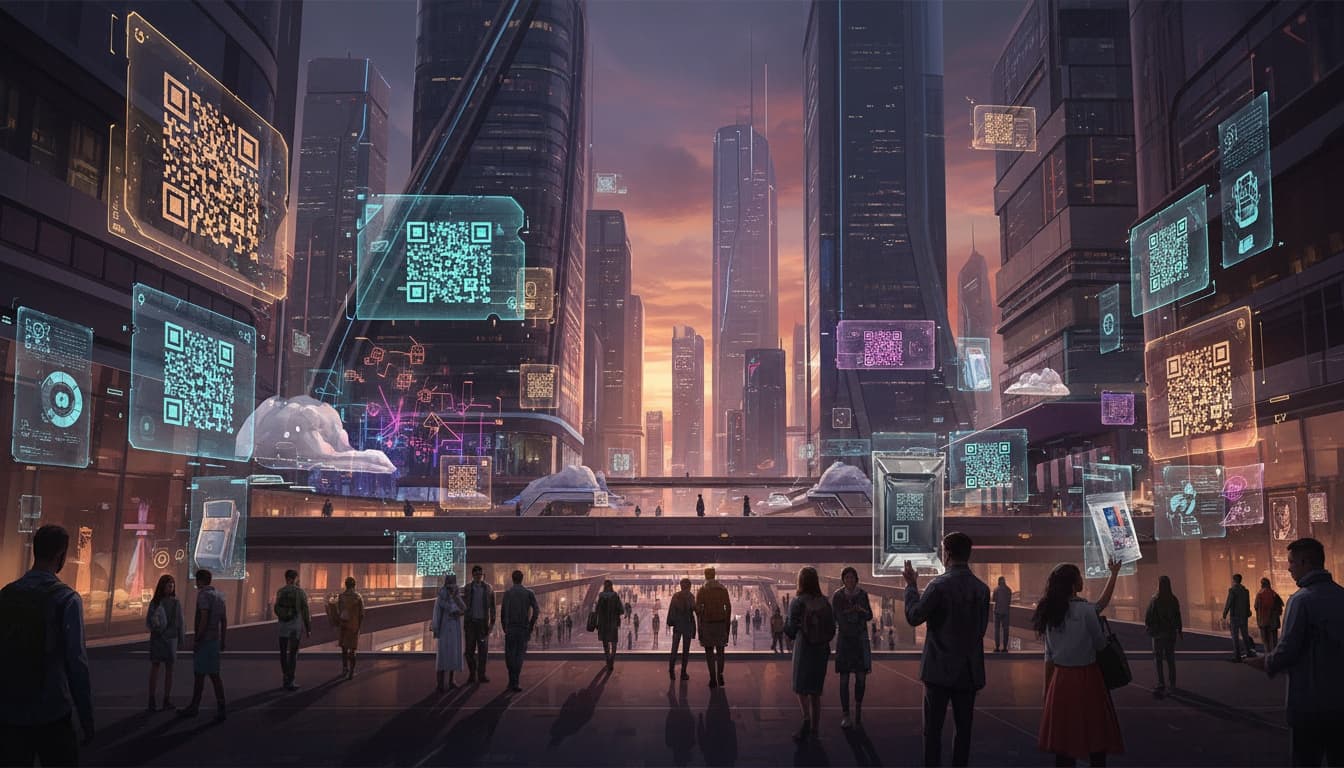QR Codes and Artificial Intelligence: Real-Time Personalization
How AI Can Optimize QR Code Campaigns Based on User Behavior
The marriage of QR codes and artificial intelligence is transforming how businesses connect with customers. What was once a simple bridge between physical and digital worlds has evolved into an intelligent, adaptive marketing tool that learns, predicts, and personalizes experiences in real-time.
What Are AI-Powered QR Codes?
AI-powered QR codes combine traditional QR code technology with machine learning algorithms and real-time data processing to create intelligent, adaptive experiences. Unlike static QR codes that always lead to the same destination, AI-enhanced QR codes make split-second decisions about what content to display based on:
- User Demographics: Age, location, language preferences
- Behavioral Data: Previous interactions, browsing history, purchase patterns
- Contextual Factors: Time of day, weather, device type, network speed
- Real-Time Events: Inventory levels, promotional periods, trending topics
- Predictive Analytics: Likelihood to convert, product recommendations, churn risk
Real-World Example
A coffee shop chain implements AI-powered QR codes on their tables. When scanned:
- A first-time visitor sees a welcome offer and menu highlights
- A regular customer sees their favorite orders for quick reorder
- A morning scanner sees breakfast combos
- An afternoon visitor sees dessert and specialty drinks
- A loyalty member close to their next reward sees progress and incentives
Result: 47% increase in average order value and 62% boost in repeat visits.
Turn real-world scans into personalized journeys.
Connect AI-powered QR to measurable outcomes with VISU.
How AI Optimizes QR Code Campaigns

1. Dynamic Content Personalization
AI algorithms analyze user data in milliseconds to serve personalized content:
Product Recommendations
Machine learning models predict which products a user is most likely to purchase based on their scan location, time, and historical data. Rather than showing a generic catalog, the QR code landing page dynamically arranges products by relevance score.
Language and Localization
AI detects the user’s device language settings, location, and even analyzes their previous content consumption to serve content in their preferred language with culturally relevant messaging and imagery.
Content Format Optimization
Based on device type, screen size, and network speed, AI determines whether to serve video content, image galleries, text-heavy pages, or interactive experiences. A user on a slow 3G connection might receive a lightweight, text-based page, while someone on 5G gets rich media content.
2. Predictive Analytics and Behavior Modeling
AI doesn’t just react—it predicts. By analyzing patterns across thousands or millions of QR code scans, machine learning models can:
Predict Purchase Intent
Algorithms assess the probability that a specific user will complete a purchase. High-intent users might see direct checkout options, while low-intent browsers receive educational content or social proof to build confidence.
Optimal Timing for Engagement
AI identifies when individual users are most likely to engage. If data shows a user typically makes purchases on Thursday evenings, the system can trigger personalized push notifications or special offers at that optimal time after they’ve scanned a QR code.
Churn Prevention
For loyalty programs and subscription services, AI identifies users showing signs of disengagement. When these at-risk users scan a QR code, they might receive special retention offers or re-engagement content that others don’t see.
3. A/B Testing on Steroids: Multivariate Optimization
Traditional A/B testing is slow and limited. AI-powered QR codes enable continuous multivariate testing:
- Multi-Armed Bandit Algorithms: Instead of splitting traffic 50/50 between two variants, AI dynamically allocates more traffic to better-performing versions while still exploring new possibilities
- Personalized Experiments: Different user segments can simultaneously experience different tests, accelerating learning
- Real-Time Optimization: As soon as statistical significance is reached, the system automatically shifts to the winning variant
Impact of AI-Powered Optimization
- 67% faster to statistical significance than traditional A/B testing
- 23% average improvement in conversion rates
- Up to 10x more variations tested simultaneously
4. Smart Call-to-Action (CTA) Selection
Not all users respond to the same CTAs. AI analyzes user psychology and behavior to select the most effective call-to-action:
- Urgency-Driven Users: “Limited Time Offer – 2 Hours Left!”
- Value Seekers: “Save $50 Today – Compare Prices”
- Social Proof Responsive: “Join 50,000+ Happy Customers”
- Risk-Averse: “Try Free for 30 Days – No Credit Card Required”
- Status-Conscious: “Exclusive Access for VIP Members”
5. Contextual Intelligence
Location-Based Adaptation
QR codes on subway posters adapt based on the station. A code scanned in a financial district might emphasize professional products, while the same campaign in a college area highlights student discounts.
Weather-Responsive Content
By integrating weather APIs, AI can adjust product recommendations. A restaurant’s QR code might promote hot soups on cold days and cold beverages during heat waves.
Inventory-Aware Recommendations
Real-time inventory integration ensures AI never recommends out-of-stock items. If a popular product runs low, the system automatically pivots to promote available alternatives.
6. Natural Language Processing (NLP) for Smart Forms
- Intent Recognition: Understanding what users want from minimal input
- Smart Auto-Complete: Predicting and suggesting responses based on partial input
- Sentiment Analysis: Detecting frustration and adapting the conversation flow
- Voice Input Optimization: For mobile users, enabling voice commands and transcription
Implementation Strategies for AI-Powered QR Codes

Step 1: Data Foundation
AI needs data to learn. Start by collecting:
- Scan timestamps and locations
- Device information (type, OS, browser)
- User demographics (where legally compliant)
- Session behavior (time on page, clicks, conversions)
- Historical customer data (CRM integration)
Step 2: Choose Your AI Stack
You don’t need to build from scratch. Several platforms offer AI-powered QR solutions:
Enterprise Solutions
- Visu Network: Built-in AI personalization with gamification and monetization features
- Adobe Experience Cloud: Deep integration with marketing automation
- Salesforce Marketing Cloud: CRM-powered personalization
For Developers: Build Your Own
Tech stack for custom solutions:
- ML Frameworks: TensorFlow, PyTorch, Scikit-learn
- Real-Time Data: Apache Kafka, Google Cloud Pub/Sub
- Personalization Engines: Amazon Personalize, Google Recommendations AI
- CDN for Fast Delivery: Cloudflare, Fastly with edge computing
Step 3: Integrate with Existing Systems
- CRM: Customer profiles and purchase history
- Inventory Management: Real-time stock levels
- Marketing Automation: Email, SMS, push notification systems
- Analytics: Google Analytics, Mixpanel, Amplitude
- Payment Gateways: For seamless checkout experiences
Step 4: Continuous Learning Loop
- Collect: Gather scan and conversion data
- Analyze: Identify patterns and anomalies
- Train: Update ML models with new data
- Deploy: Push improved models to production
- Monitor: Track performance metrics
- Iterate: Refine and repeat
Industry-Specific Use Cases
Retail and E-Commerce
Smart Product Packaging
QR codes on product packaging use AI to:
- Show personalized recipes based on purchased items
- Recommend complementary products
- Offer loyalty rewards based on purchase frequency
- Provide targeted upsell opportunities at optimal moments
In-Store Navigation
AI analyzes shopping lists and past purchases to create personalized store navigation routes, showing each customer the most efficient path through the store.
Restaurants and Hospitality
Dynamic Menus
- Highlight dishes based on dietary restrictions (detected from past orders)
- Adjust pricing based on demand (dynamic pricing)
- Recommend wine pairings based on entree selections
- Show nutritional information for health-conscious diners
- Offer personalized chef specials based on taste preferences
Events and Entertainment
Personalized Event Experiences
- Create custom schedules based on attendee interests
- Recommend networking connections with similar professionals
- Provide real-time crowd management (directing to less busy areas)
- Offer dynamic content based on session attendance
Real Estate
Intelligent Property Tours
- Show properties matching buyer’s search history
- Provide mortgage calculations based on buyer’s prequalification
- Recommend similar properties in preferred neighborhoods
- Schedule tours at optimal times based on buyer availability patterns
Healthcare
Patient Education and Compliance
- Personalized medication instructions based on patient history
- Risk-appropriate educational content
- Reminders scheduled based on optimal adherence patterns
- Multi-language support for diverse patient populations
Privacy, Ethics, and Compliance
With great personalization power comes great responsibility. AI-powered QR codes must navigate:
GDPR and Data Protection
- Consent: Clear opt-ins for data collection and personalization
- Transparency: Users should know what data is being used and how
- Right to Delete: Easy mechanisms for users to request data deletion
- Data Minimization: Collect only what’s necessary for personalization
Avoiding Discrimination
AI models can inadvertently discriminate. Best practices include:
- Regular bias audits of ML models
- Diverse training datasets
- Fairness constraints in optimization algorithms
- Human oversight for sensitive decisions
Transparency in Personalization
Users appreciate knowing why they’re seeing specific content. Consider:
- Subtle indicators like “Recommended for you because…”
- Options to disable personalization
- Clear privacy policies accessible from QR landing pages
Privacy-First Personalization
- Use anonymized identifiers when possible
- Implement on-device AI for sensitive data
- Provide clear value exchange for data sharing
- Regular security audits and penetration testing
Measuring AI-Powered QR Code Success
Key Performance Indicators (KPIs)
Engagement Metrics
- Scan Rate: Total scans vs. total impressions
- Time on Page: Average session duration after scan
- Bounce Rate: Percentage of single-page sessions
- Click-Through Rate: Engagement with personalized content
Conversion Metrics
- Conversion Rate: Scans that result in desired action
- Average Order Value: For e-commerce applications
- Lead Quality Score: For B2B campaigns
- Customer Lifetime Value: Long-term impact on revenue
AI Performance Metrics
- Model Accuracy: Prediction correctness
- Personalization Lift: Improvement vs. non-personalized experience
- Response Time: Speed of AI decisions
- Exploration vs. Exploitation Ratio: Balance in learning new patterns
ROI Calculation Framework
AI-Powered QR Code ROI
ROI = (Revenue from AI-Enhanced Campaigns – Campaign Costs – AI Implementation Costs) / Total Investment
Where: Revenue includes direct sales and attributed lifetime value; Campaign Costs include design, printing, distribution; AI Implementation Costs include platform fees, development, data infrastructure.
Attribution Modeling
- First-Touch Attribution: Credit to the first QR code interaction
- Last-Touch Attribution: Credit to the final touchpoint before conversion
- Multi-Touch Attribution: AI-weighted credit across the entire journey
- Time Decay Attribution: More credit to recent interactions
The Future of AI-Powered QR Codes
Emerging Technologies
1. Computer Vision and AR Integration
- Detect nearby products to offer relevant information
- Recognize user emotions via camera to adjust content tone
- Overlay AR content that adapts to user preferences
2. Voice-First Experiences
- Natural language product consultations
- Voice-activated purchases
- Hands-free navigation for accessibility
3. Blockchain for Trust and Transparency
- Immutable scan history for supply chain verification
- Decentralized personalization that gives users data control
- Token-based rewards for data sharing
4. Federated Learning for Privacy
- Personalization without privacy compromise
- Faster response times (no server round-trip)
- Compliance with strictest data regulations
5. Quantum Computing for Hyper-Personalization
- Real-time optimization of millions of variables
- Predictive models with unprecedented accuracy
- Complex scenario modeling for personalization strategies

Industry Predictions for 2025-2030
- 75% of QR code campaigns will use some form of AI by 2027
- Average conversion rate improvement of 40% for AI-powered vs. static QR codes
- 90% of Fortune 500 companies will deploy AI-enhanced QR strategies
- New job category: “QR Code AI Specialist” with average salary exceeding $120K
- Regulatory frameworks specifically addressing AI-powered marketing personalization
Getting Started: Your Action Plan
Week 1: Audit and Planning
- Inventory existing QR code campaigns
- Assess current data collection capabilities
- Define personalization goals and KPIs
- Identify quick wins for AI implementation
Week 2-4: Foundation Building
- Select an AI-powered QR code platform (or development approach)
- Integrate with existing marketing stack
- Set up data pipelines and tracking
- Create initial personalization rules
Month 2: Pilot Campaign
- Launch small-scale AI-powered QR code campaign
- Run A/B test: AI-powered vs. traditional QR codes
- Monitor performance daily
- Gather user feedback
Month 3+: Scale and Optimize
- Expand successful pilots to broader campaigns
- Implement advanced AI features (predictive analytics, NLP)
- Train team on AI-powered campaign management
- Continuously refine models based on performance data
Ready to Transform Your QR Code Campaigns?
Visu Network offers enterprise-grade AI-powered QR code solutions with built-in personalization, analytics, and monetization features.
- ✅ No coding required – intuitive dashboard
- ✅ Pre-built AI models for common use cases
- ✅ Real-time analytics and optimization
- ✅ GDPR-compliant data handling
- ✅ Seamless integration with your existing tools
Start your free trial today and see 30%+ improvement in campaign performance.
Conclusion: The Intelligent Future of Customer Engagement
AI-powered QR codes represent more than just a technological upgrade—they’re a fundamental shift in how businesses interact with customers. By combining the simplicity and ubiquity of QR codes with the intelligence of AI, companies can deliver personalized experiences at scale, turning every scan into an opportunity for meaningful engagement.
The key to success lies in balancing sophistication with simplicity, personalization with privacy, and automation with human oversight. As AI technology continues to evolve, those who embrace intelligent QR code strategies today will build competitive advantages that compound over time.
The question is no longer whether to adopt AI-powered QR codes, but how quickly you can implement them to stay ahead in an increasingly personalized digital landscape.
Ready to personalize every scan with AI?
Launch AI-powered QR flows, reward real attention, and measure the complete journey from scan to purchase.
Key Takeaways
- 🎯 AI-powered QR codes deliver 3x higher conversion rates through real-time personalization
- 🧠 Machine learning optimizes content, timing, and CTAs based on user behavior
- 🔄 Continuous learning loops improve performance automatically over time
- 🛡️ Privacy-first implementation is essential for trust and compliance
- 📈 Measurable ROI through sophisticated attribution and analytics
- 🚀 Early adopters will gain significant competitive advantages
References
FAQ: AI-Powered QR Codes
How are AI-powered QR codes different from regular QR codes?
They personalize content in real time using behavior and context (device, time, location, history), increasing relevance and conversions.
Do I need a dedicated app for AI-powered QR experiences?
No. Most cameras scan natively. AI runs on the destination layer (rules, models, personalization) after the scan.
What data is typically used for personalization?
Scan metadata (time, device), page behavior, and optional CRM signals where legally compliant. Use privacy-by-design and clear consent.
Can I update or test variants after printing the code?
Yes. With dynamic QR and server-side logic you can A/B test, route segments and switch offers without reprinting.
How do I measure success for AI-powered QR campaigns?
Track scans, click-throughs, conversion rate, AOV, retention and the lift from personalization compared to a baseline.

